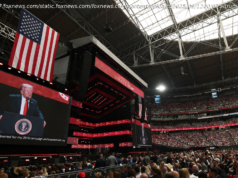Police have given demonstrators in the latest St. Louis protests a wide berth, applying a lesson learned in nearby Ferguson to offer protesters ample room to have their say, at least until…
ST. LOUIS (AP) – Police have given demonstrators in the latest St. Louis protests a wide berth, applying a lesson learned in nearby Ferguson to offer protesters ample room to have their say, at least until trouble starts.
But critics complain that the tactic comes with an unjust catch: If vandalism or rock throwing begin, officers order crowds to disperse and block all exits. The result, they say, is an arrest net that sweeps up journalists, bystanders and peaceful demonstrators.
The most recent round of protests began Friday after a judge acquitted former St. Louis police officer Jason Stockley, who is white, of murder in the death of a black drug suspect, Anthony Lamar Smith.
In Ferguson, police drew heavy criticism for their militarized response to protests after unarmed 18-year-old Michael Brown, who was black, was fatally shot on Aug. 9,2014, by white officer Darren Wilson, who was not charged and later resigned.
This time around, officers standing near protests do not respond to verbal abuse, nor do they intervene when demonstrators engage in minor civil disobedience like blocking streets. In fact, officers reroute traffic to keep them safe.
At times in Ferguson, police would converge on protesters throwing things at them or breaking windows, then allow the protest to continue. But now, once things take a turn for the worse, authorities declare that the protest is over.
David Klinger, a University of Missouri-St. Louis criminologist and former Los Angeles police officer, said officers face a difficult task because they do not want to break up a protest without cause, but they must act quickly to protect people and property when things go awry.
« The key to managing a gathering is to move in and catch it at that moment, » Klinger said. « When rocks and bottles start coming or people start smashing cars or windows, that’s the inflection point. »
When the trouble begins, additional officers quickly arrive from staging areas, with shields, helmets and gas masks. They form lines blocking streets. An officer on a bullhorn announces that the demonstration is no longer a lawful assembly and order people to disperse.
Then the police lines start to close in, and arrests are made. The process is aimed at containing people into a limited area – a practice known as « kettling. » But it has drawn objections from those who say it ensnares innocent people who cannot escape and subjects them to rough treatment that can include being struck by officers and pepper sprayed, not to mention detained for hours.
The tactics were used Sunday when, after a long and peaceful day of protests, about 100 people lingered and marched into downtown St. Louis. A small number of those in the group broke windows, smashed concrete flower pots and threw things at police.
Hundreds of officers in riot gear emerged and eventually encircled the group. When officers began tapping batons in unison, it seemed like a signal to move in.
Many of the 123 people arrested were caught in the kettle. But some were not protesters. Some said they were just bystanders. At least one was a journalist.
In fact, all but three of the 123 arrests were for the municipal citation « failure to disperse. » One man was arrested for resisting arrest, one for disturbing the peace and one for riding a bike on a sidewalk. No one was charged with assaulting an officer or destroying property.
St. Louis Post-Dispatch journalist Mike Faulk told the newspaper he heard repeated commands to « move back » but had nowhere to go. He said officers knocked him down, and he was pepper sprayed in the face.
Some arrested protesters said they were roughed up.
Sean Porter, 25 of St. Louis, said he could not leave despite the order to disperse because police blocked every corner.
« They threw us on the ground, sprayed us, hit us, everything, » Porter said. « It was tragic. »
St. Louis police said in a statement that the new tactics are deployed « when criminal activity arises » and that « escalation depends on the level of aggression. »
The kettling process has been used on protesters before, including at demonstrations on the day President Donald Trump was inaugurated, when 230 people were arrested in Washington. The ACLU alleged in a lawsuit that many of those arrested were innocent people.
The ACLU is considering a lawsuit over the St. Louis arrests, ACLU of Missouri attorney Anthony Rothert said.
Protesters were also angered by police chanting « Whose streets? Our streets! » Sunday night, a chant captured on video and posted on social media. It’s one of the many chants common during demonstrations.
St. Louis police spokeswoman Schron Jackson said the department is reviewing the footage.
« We hold our officers to the highest standards of professionalism and any officer not meeting those standards will be held accountable, » she said.
In a statement issued Tuesday, Mayor Lyda Krewson said the police department’s internal affairs division is reviewing complaints of misconduct. Although officers are working long hours in « tense and hostile situations, » she said, the mayor and the chief expect them to « conduct themselves professionally. »
Despite the occasional flare-ups, St. Louis County police spokesman McGuire said the protests are far cry from those in Ferguson.
« We’re not getting shot at this go-around, » McGuire said. « The main difference now is the gunshots and the looting aren’t happening. »
Copyright 2017 The Associated Press. All rights reserved. This material may not be published, broadcast, rewritten or redistributed.






